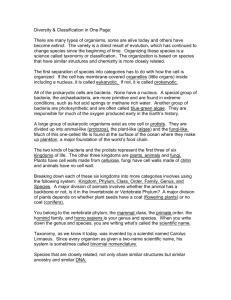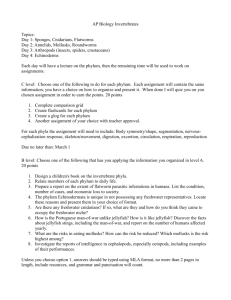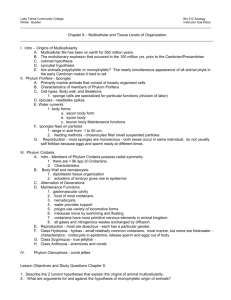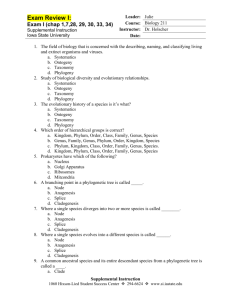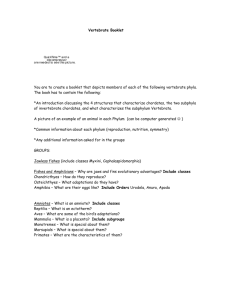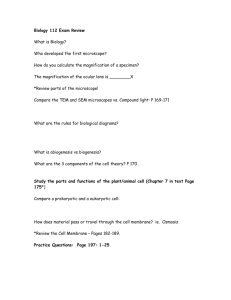Biology 112 Exam Review June 2011
advertisement
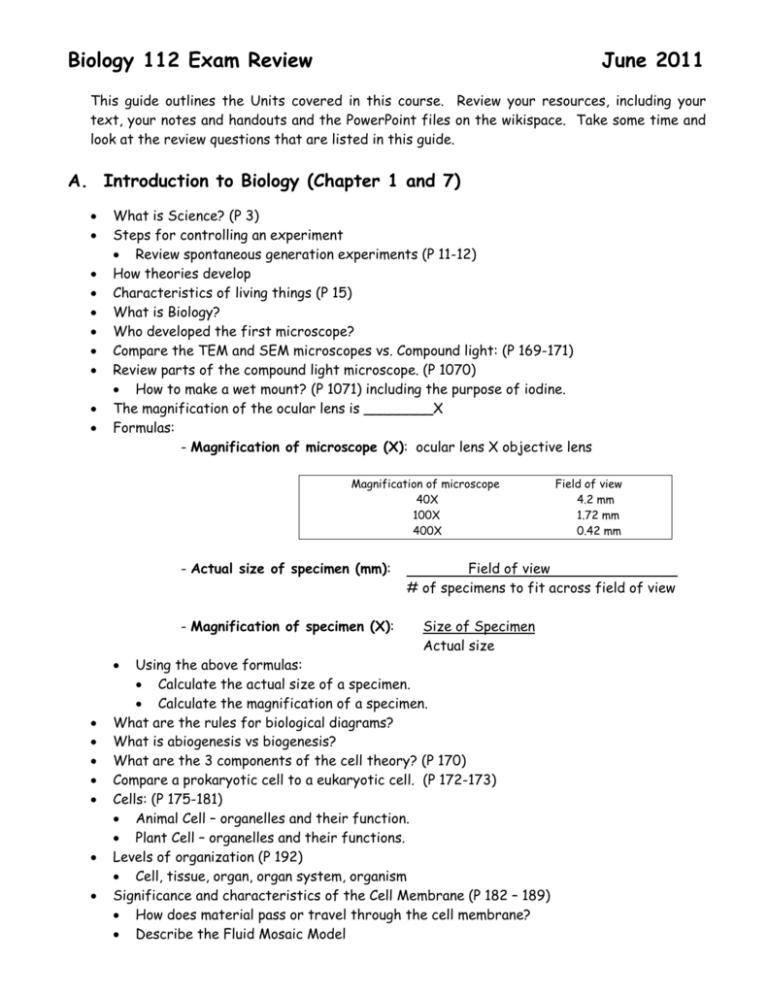
Biology 112 Exam Review June 2011 This guide outlines the Units covered in this course. Review your resources, including your text, your notes and handouts and the PowerPoint files on the wikispace. Take some time and look at the review questions that are listed in this guide. A. Introduction to Biology (Chapter 1 and 7) What is Science? (P 3) Steps for controlling an experiment Review spontaneous generation experiments (P 11-12) How theories develop Characteristics of living things (P 15) What is Biology? Who developed the first microscope? Compare the TEM and SEM microscopes vs. Compound light: (P 169-171) Review parts of the compound light microscope. (P 1070) How to make a wet mount? (P 1071) including the purpose of iodine. The magnification of the ocular lens is ________X Formulas: - Magnification of microscope (X): ocular lens X objective lens Magnification of microscope 40X 100X 400X - Actual size of specimen (mm): - Magnification of specimen (X): Field of view # of specimens to fit across field of view Size of Specimen Actual size Using the above formulas: Calculate the actual size of a specimen. Calculate the magnification of a specimen. What are the rules for biological diagrams? What is abiogenesis vs biogenesis? What are the 3 components of the cell theory? (P 170) Compare a prokaryotic cell to a eukaryotic cell. (P 172-173) Cells: (P 175-181) Animal Cell – organelles and their function. Plant Cell – organelles and their functions. Levels of organization (P 192) Cell, tissue, organ, organ system, organism Significance and characteristics of the Cell Membrane (P 182 – 189) How does material pass or travel through the cell membrane? Describe the Fluid Mosaic Model Field of view 4.2 mm 1.72 mm 0.42 mm Properties of the lipid bilayer Compare hydrophobic region to hydrophilic region Classification of Membrane Protein: integral, peripheral and lipid-bound proteins Compare passive transport to active transport Compare diffusion to osmosis Compare endocytosis to exocytosis Compare phagocytosis to pinocytosis Chapter 1 Practice Questions: Page Page Page Page Page 7: 1 - 6 14: 5 22: 1 – 6 28: 1 - 3 31: 1 – 12, 15, 18, 19, 20 Chapter 7 Practice Questions: Page Page Page Page Page Page 173: 181: 189: 193: 197: 199: 1 1 1 1 1 1 – 5 – 4 – 6 - 3 – 25 – 10 B. Taxonomy - Classification and Diversity (Chapter 18) What is taxonomy? (P 447) Who is Carolus Linnaeus? What is binomial nomenclature? What are the seven taxonomic categories in order (smallest to largest)? What is a dichotomous key and how is it used? Practice scientific classification using a dichotomous key (P 462 – 463) What is phylogeny and how does the system work? What is a clades? Practice interpreting cladograms. What is the “Tree of Life” and why is it significant? Identify the 3 domains General characteristics of each kingdom within its domain (P 459 – Table) Identify the 6 kingdoms If two organisms are in the phylum, they must belong to the same __________. Chapter 18 Practice Questions: Page Page Page Page Page 450 : 455 : 461 : 465: 467: 1 1 1 1 1 – 6 – 6 - 6 – 19, 20 – 25 – 10 C. Bacteria and Viruses (Chapter 19) Chapter 19 Bacteria What is the difference between archaebacteria and eubacteria? (P 472) Label parts of a bacterium (Figure 19-2). What are the characteristics of a prokaryote? (P 473) What are three shapes of bacteria? (P 473) What is the purpose of gram-staining? Consider color (P 473) How does a prokaryote obtain energy? (P 473) What is the difference between obligate aerobes, obligate anaerobes and facultative anaerobes? (P 474) What are the three methods of reproduction in bacteria? (P 475) What is binary fission? (P 475) What is conjugation in bacteria? (P 475) What is an endospore and why is it important to bacteria? (P 475) Why are bacteria so important to the living world? (P 476) What is nitrogen fixation? (P 476) Bacteria Growth Lab. What material was used to grow bacteria? What is agar? What are antibiotics? Chapter 19 Viruses What are the general characteristics of a virus? (P 478) What are the three basic structures of a virus? (P 479) What parts do all viruses have in common? What is a T4-bacteriophage? (P 479) Describe the lysogenic (dormant) cycle. (P 480) Describe the lytic (active) cycle. (P 480) What is a retrovirus? (P 482) Why is there controversy as to whether a virus is living or non-living? (P 483) What is a pathogen? (P 485) Do viruses and bacteria cause disease in the same way? Explain. (P 485, 488) What is the difference between viroids and prions? (P490) How do viruses enter the body? Identify four ways viruses spread. What role does the immune system have in fighting a virus? Do you think viral infections are difficult to treat? Why or why not? What is a vaccination and how are they used to protect against some viral diseases? What is virology? Compare a virus to a bacterium. Examples of viruses and bacteria Why do antibiotics normally work on bacteria but not viruses? Chapter 19 Practice Questions: Page Page Page Page 477: 483: 493: 495: 1 1 1 1 – 6 - 5 – 25 – 10 D. Protists (Chapter 20) What are the characteristics of protists? (P 497) How are they different from other groups? (P 497) What are the three main groups of protists? (P 498) What characteristics distinguish plant-like protists from animal-like protists? Give examples of each group. What is another name for Animal-like Protists? (P 499) What are the four types of Animal-like Protists? (P 499) How is the main distinguishing feature? What is a pseudopod and how does it work? (P 500) What is amoeboid movement? (P 500) See Figure 20-4. The amoeba. What is the function of cilia on the surface of Paramecium? (Think lab) (P 501-502) See Figure 20-5. The paramecium. What is malaria and how is it spread? (P 503) What is the vector for malaria? What are symptoms of malaria? What are volvox? What do they look like? (P 512 and lab) Why are protists important to life in pond habitat? What is the difference between holozoic and saprozoic? (See Notes) Compare protists to prokaryotes. Review Protist Lab. Chapter 20 Practice Questions: Page 498: 1 - 5 Page 523: 1 – 8, 13, 14, 15 E. Kingdom Animalia (Chapters 26, 27, 28, 30, 32) Chapter 26 Intro to Kingdom Animalia What is an animal? (P 657) Compare invertebrates to vertebrates. (P 657) Essential functions performed by all animals. (P658-659) Practice interpreting Phylogenic Tree on Animal Evolution, Figure 26-3. (P 660) What is the difference between protosome and deuterostomes? (P 661) See Figure 26-4 What are the three germ layers in all animals (except sponges)? (P 661) What are the two types of body symmetry? (P 662) Describe cephalization and its significance. (P 663) What is the difference Subkingdom Parazoa versus Subkingdom Metazoa? Characteristics common in animals. Review dissection terms. (Handout) INVERTEBRATES Chapter 26 Phylum Porifera Why is the phylum name Porifera appropriate for sponges? Characteristics of a sponge (P 664) - See Figure 26-8 Cells of a sponge. (P 665) What are the functions of choanocytes (also known as collar cells)? What are the functions of archaeocytes (also known as amebocytes) What are spicules composed of? (P 665) What is filter feeding? (P 665) How does water move through a sponge? What do sponges rely on for proper respiration, circulation and excretion? (P 666) How do sponges protect themselves? (P 666) Describe sexual reproduction in sponges. (P 666) - See Figure 26-9 Which stage(s) of the sponge are motile? Are sessile? What methods are used to asexually reproduce? (P 667) Under what conditions would a sponge form gemmules? Why are sponges important to ecosystems? (P 667) Which subkingdom do sponges below in? What is an ostia? Which germ layers do sponges have? Chapter 26 Phylum Cnidaria Characteristics of a Cnidarian. Give examples. See Figure 26-11 (P 669) What is the purpose of a cnidocyte (stinging cell) and where is it found? What is a nematocyst and where is it found? What are the two stages of a cnidarian life cycle? (P 670) Do all cnidarians have these two stages? Which stage is the body plan of an adult jelly fish? Of an adult hydra? What are the three tissue layers in cnidarians? (P 670) How is undigested food removed in cnidarians? (P 670) How do cnidarians eliminate their waste? (P 670) What is the purpose of a nerve net? (P 670) What is the purpose of a hydrostatic skeleton? (p 670) Do all cnidarians have a hydrostatic skeleton? Most cnidarians reproduce sexually and asexually. (P 672) What asexual methods do cnidarians use? How do polyps reproduce? When cnidarians use sexual reproduction, what type of fertilization takes place? Are hydras carnivorous? What do they eat? HYDRA LAB Review the labeled diagram. What is the body shape of an adult hydra? Is the adult sessile or motile? Why was a depression slide used for this lab? What is the risk of using a live specimen? Chapter 26 Practice Questions: Page Page Page Page Page 663: 667: 675: 679: 681: 1 1 1 1 1 – – – – – 6 3 4, 6 10, 15, 16, 17, 19, 22, 23. 11 Chapter 27 Worms Do all worms exhibit bilateral symmetry? All worms have 3 germ layers: ectoderm, mesoderm and endoderm. Chapter 27 Phylum Platyhelminthes (Flatworms) Characteristics of flatworms. (P 683) What does it mean to be an acoelomate? What is cephalization? Feeding and excretion in flatworms. Refer to Figure 27-3 for clarity. (P 684) How many openings in the digestive cavity? How do flatworms feed? What is the pharynx and where is it located? How do flatworms remove waste? What is a flame cell? What type of circulatory system? See Figure 27-3 for organization of a flatworm (P 685) Do flatworms have a brain? What is the purpose of the eyespot? How do flatworms reproduce? (P 686) Key characteristics of Class Turbellaria Are classes free-living or parasitic? Review notes on Planaria. If a planaria is split into two parts, what will happen? Key characteristics of Class Trematoda Are classes free-living or parasitic? What is the purpose of the cuticle? Where are they found? What is the potential danger when removing a fluke? Key characteristics of Class Cestoda Are classes free-living or parasitic? What are proglottids? What is the danger when removing a tapeworm? Chapter 27 Phylum Nematoda (Roundworms) Characteristics of roundworms (P 689) How many openings in the digestive cavity? What is a pseudocoelem? How do roundworms sexually reproduce? (P 690) How is waste removed? (P 690) What is a hookworm and how does it spread? Chapter 27 Phylum Annelida (Segmented Worms) Characteristics of segmented worms. (P 694) How do segments differ from proglottids? What is the purpose of setae? What is the difference between the gizzard and the crop? (P 695) What is a closed circulatory system? (P 695) What are the two major blood vessels? (P 695) How do segmented worms breathe? Aquatic and land dwelling. (P 696) Do annelids have a nervous system? What does it include? (P 696) What is the purpose of the nephridia? (P 696) What methods do annelids use for reproduction? (P 696) What is the clitellum and how does it help with reproduction? (P 696) What are three main classes of Phylum Annelida? (P 697-698) Key characteristics of Class Oligochaeta (Earthworms). See Figure 27-16. Which class contains leeches? What is the purpose of the peritoneum? EARTHWORM DISSECTION LAB Review labeled image of the earthworm. List the organs (in order) that are part of the digestive process in the earthworm. Begin at the mouth. How do earthworms reproduce? What are the two major blood vessels in the circulatory system? How many hearts does the earthworm have? Chapter 28 Phylum Arthropoda What are the three basic characteristics of an arthropod? (P 715) What is chitin? What do tracheal tubes, book lungs and featherlike gills have in common? (P 717) What type of circulatory system do arthropods have? (P 717) What is the haemoceol? What are malpighian tubules (P 717) Do all arthropods have a brain? (P 718) All arthropods molt. How does molting happen? (P 719) Review the Arthropod Coloring Worksheet packet (Handout) Chapter 28 Groups of Arthropods What are the characteristics of Subphyla Chelicera? (P 722) What are the two major body segments? How many legs do they normally have? What are the characteristics of Subphyla Mandibulata? What are the three major body segments? How many pairs of walking legs do these subphyla normally have? Does this subphyla have antennae? What is a mandible? To which subphyla does the Grasshopper belong? the Spider belong? The insect belong? What are primary characteristics of Class Crustacea? Class Diplopoda? Class Chilopoda? Can you give examples of each. (Handout) GRASSHOPPER DISSECTION LAB Review the labeled diagram from lab and coloring sheet. (Handout) Why did you wash the grasshopper off before examining it? What is the function of the labrum, mandibles, maxillae and labium? What is the function of tracheal tubes? Spiracles? How can you determine the grasshoppers sex? VERTEBRATES Chapter 30 Phylum Chordata What four characteristics do all chordates share? (P 767) What is the function of a notochord? What is the function of a pharyngeal pouch? Phylum Chordata is broken into three groups: Subphyla Vertebrae, Subphyla Tunicates and Subphyla Lancelets What is the function of a vertebrae? (P 768) What does a vertebrae replace in some chordates? (P 768) What are the two subphyla that are nonvertebrates (do not have a backbone)? (P 769) What do the nonvertebrates have instead of a backbone? (P 769) Subphyla Vertebrae can be broken down into 7 classes. What are they? Chapter 30 Fishes What characteristics do all fish posses? (P 771) What are the functions of the scales? The fins? The gills? (P 771) Fins were the second important evolutionary change, what was the first? (P 773) Why was it important? How were the pectoral and pelvic fins attached following the evolutionary change? What is cartilage? What structures do fish use for gas exchange (to breathe)? (P 775) What are filaments? What is the benefit of a fish having an operculum? Why is the African lungfish unique? (P 775) What type of circulatory system do fishes have? How many chambers are in a fish’s heart? (P 776) How do fishes remove waste from their bodies? (P 776) Which part of the fish’s brain is responsible for smell? (P 777) What is the function of the lateral line? (P 777) How does the swim bladder help with movement? (P 777) Compare oviparous, ovoviviparous and viviparous. (P 778) What are three main groups of modern day fishes? (P 778 - 780) Give examples for each of the groups. What characteristics are unique for the each group? Which group is lacking a backbone? Which group has a skeleton comprised of cartilage? Which group includes ray-finned fishes? Which group includes lobe-finned fishes? Compare lampreys to hagfishes. (P 778) What is the difference between anadromous and catadromous? (P 781) PERCH DISSECTION LAB Review the lab questions and the labeled diagram. (See Figure 30-6) Name the fins and describe their function. In order, name the digestive organs through which food passes. What is the function of gill rakers. How does the external coloration help protect the fish from predators? How did you distinguish the sex of your fish? F. Plant Diversity / Roots, Stems and Leaves (Chapter 22 / 23) Chapter 22 Plant Diversity Using the plant study table, compare: Land plants = nonvascular vs. vascular. Vascular = seedless vs. seed. Seed plants = gymnosperms vs. angiosperms. What is a plant? (P 551) What does alternation of generations mean? (P 552) Compare sporophytes to gametophytes. (P 552) What are four things plants need to survive? (P. 552) What do evolutionary scientists believe the first plants came from? (P 554) What are the four main groups of plants? Which has the greatest group? (P. 555) What are general characteristics of Bryophytes? (P 556) What are the three groups of Bryophytes? (P 556-557) What is necessary to ensure fertilization of Bryophytes? (P 558) How is the water transport system different in ferns compared to bryophytes? What are examples of seedless vascular plants? What is the dominant generation of the life cycle of the fern? (P 562) Which generation has the plant stage we recognize as a fern? Is water necessary for reproduction in the life cycle of ferns? (P 562) What are the differences between gymnosperms and angiosperms? (P 564) Consider cones versus flowers, What three adaptations allow seed plants to reproduce without water? (P564) In seed plants, compare pollination to fertilization. (P 565) What are the four groups of gymnosperms? (P 566-567) What are the parts of a flower? Think Flower Dissection Lab. What is pollen? How does pollination differ from fertilization? What is the purpose of fruit in a flowering plant? (P 589) Characteristics of monocot and dicots. What makes them different? Figure 22-25 (P 570) What is the difference between annuals, biennuals and perennials? (P 571 - 572) Chapter 23 Roots, Stems and Leaves Characteristics of three tissue systems of plants: dermal, vascular, ground (P 580) What are the differences between xylem and phloem. (P 581) How do materials and fluids move through plants? Cell types that make up ground tissue. (P. 582) How plants grow? Think types of meristems. (P582-583) Compare the two types of roots: taproots to fibrous roots. (P 584) What is a radicle? Function of roots. What are the important functions of stems? (P 589) Review parts of a stem. Layers of growth in a mature tree. Figure 23-15 Leaf structure. Review the parts of the Leaf (P 596) See Figure 23-18 What are stomata and how do they function? (P 597) See Figure 23-19 LEAF ANATOMY LAB: What are the parts of the leaf? What are the functions of these parts? What are the locations of these parts? How does gas exchange occur in the leaf? Chapter 24: Reproduction of Seed Plants (Gymnosperms and Angiosperms) What are the reproductive structures of gymnosperms and angiosperms? (P 609) What are the parts of a flower? (P 612) What are the reproductive structures of an angiosperm? (P 612) What is pollination? How does pollination take place? What is an endosperm? What is double fertilization? FLOWER DISSECTION LAB / MONOCOT AND DICOTS SLIDE LAB: What were the main differences between the monocots and dicots in the slides? What are the parts of the Flower (see Diagram)? Which are the female parts? Male parts? Chapter 22 Practice Questions: Page Page Page Page Page Page Page 555: 559: 563: 568: 572: 575: 577: 1 1 1 1 1 1 1 – 5 – 5 – 5 – 4 - 5 – 25 - 10 Chapter 23 Practice Questions: Page Page Page Page Page Page Page 583: 588: 594: 598: 602: 605: 607: 1 1 1 1 1 1 1 – 6 – 6 – 6 -6 - 4 – 22 – 10 Chapter 24 Practice Questions : Page 616 : 1 - 4 Page 629 : 1 – 6, 16, 17, 22 Page 631 : 1- 4 DIAGRAMS TO REVIEW / LABEL Microscope Prokaryote Eukaryote Animal Cell Plant Cell Bacteria Virus Amoeba Paramecium Sponge Hydra Worm Grasshopper (External) Perch (External) Flower Stem Leaf Monocot vs Dicots Chapter 1 and 7: Introduction to Biology Terms Chapter 1 Chap.7-1 Chapter 7-2 Chapter 7-3 Chapter 7-4 Science Observation Data Quantitative Qualitative Inference Hypothesis Spontaneous generation Redi Pasteur Controlled experiment Manipulated variable Responding variable Theory Biology Homeostasis Cell Cell theory Eukaryotic Prokaryotic Organelle Cytoplasm Nuclear envelope Chromatin Chromosome Nucleolus Ribosome Endoplasmic reticulum (smooth / rough) Ribosomes Golgi apparatus Lysosome Vacuole Mitochondrion Chloroplast Chlorophyll Cytoskeleton Centriole Deoxyribonucleic acid Cell wall Cell membrane Lipid bilayer Hydrophobic Hydrophilic Phospholipid Concentration Diffusion Equilibrium Osmosis Isotonic Hypertonic Hypotonic Facilitated diffusion Active transport Passive transport Endocytosis Phagocytosis Pinocytosis Exocytosis Cell specialization Cell Tissue Organ Organ system Organism Chapter 18: Classification and Diversity Terms Chapter 18-1 Taxonomy Binomial nomenclature Domain Kingdom Phylum Class Order Family Genus Species Taxon Chap.18-2 Chapter 18-3 Phylogeny Evolutionary classification Clades Cladogram Domain Bacteria Eubacteria Archaea Archaebacteria Peptidoglycan Eukarya Protista Fungi Plantae Animalia Chapter 19: Bacteria and Viruses Terms Chapter 19-1 Eubacteria Flagella Pilli Peptidoglycan Archaebacteria Methanogens Prokaryote Bacillus Coccus Spirillum Gram positive stain Gram negative stain Chemoheterotroph Photoheterotroph Photoautotroph Cyanobacteria Chemoautotroph Obligate aerobe Obligate anaerobe Facultative anaerobe Binary fission Conjugation Endospore Nitrogen fixation Chap.19-2 Chapter 19-3 Virus Capsid Bacteriophage Lytic infection Lysogenic infection Prophage Retrovirus Bacteriophage Pathogen Vaccine Antibiotic Viroid Prion Parasites Chapter 20: Protist Terms 20-1 20-2 20-3 Protist Zooflagellates Flagella Sarcodines Pseudopod Amoeboid movement Food vacuole Cilium Trichocysts Macronucleus Micronucleus Gullet Anal pore Contractile vacuole Conjugation Sporozoans African sleeping sickness Malaria Plasmodium Anopheles Vector Giardia Accessory pigment Eyespot Pellicle Diatoms Dinoflagellates Phytoplankton Chapter 26 – Phylum Porifera and Phylum Cnidaria Terms 26-1 Invertebrate Vertebrates Heterotrophs Autotrophs Blastula Gastrula Protostome Deutrosome Endoderm Mesoderm Ectoderm Radial symmetry Bilateral symmetry Asymmetrical symmetry Cephalization 26-2 26-3 Porifera Osculum Choanocytes Spicule Archaeocytes Filter feeders Internal fertilization Larva Gemmules Zygote Asexual Cnidarian Cnidocytes Nematocyst Polyp Medusa Sessile Epidermis Mesoglea Gastroderm Gastrovascular cavity Nerve net Ocelli Hydrostatic skeleton External fertilization Aurelia Symbiont Chapter 27 - Worms Terms 27-1,2,3 Acoelomates Coelom Pharynx Flame cell Ganglia Eyespots Planaria Hermaphrodite Fission Parasite Scolex Proglottid Testes Pseudocoelom Hook worm Septum Setae Crop Gizzard Dorsal Blood Vessel Nephridia Clitellum Chapter 28 – Phylum Arthropoda Terms 28-1 28-2 Exoskeleton Chitin Appendages Tracheal tubes Spiracle Book lung Malhphighian tubule Ganglia Molting Cephalothorax Thorax Abdomen Carapace Mandible Walking legs 28-3 Cheliped Swimmeret Chelicerae Pedipalp Spinneret Complete metamorphosis Incomplete metamorphosis Nymph Pupa Pheromone Insect society Caste Chapter 30 – Chordates and Fishes Terms 30-1 30-2 Chordate Notochord Pharyngeal pouch Hollow nerve cord Vertebrae Tunicate Lancelets Operculum Lateral line Scale Pectoral fin Dorsal fin Caudal fin Pelvic fin cartilage Esophagus Sinus venosus Atrium Ventricle Bulbus arteriosis Cerebrum Cerebellum Medula Oblongata Swim bladder Ovoviviparous Viviparous Ray finned Anadromous Catadromous Chapter 22: Plant Diversity Terms 22-1 22-2 22-3 Sporophyte Gametophyte Bryophyte Rhizoid Gemma Protonema Antheridium Archegonium Vascular tissue Tracheid Xylem Phloem Lignin Root Leaf Vein Stem Rhizome Frond Sporangium Sorus 22-4 22-5 Gymnosperm Angiosperm Cone Flower Pollen grain Pollination Seed Embryo Seed coat Fruit Monocot Dicot Cotyledon Annual Biennial Perennial Chapter 23: Roots, Stems and Leaves Terms 23-1 23-2 23-3 23-4 23-5 Epidermal Cell Vessel element Sieve tube element Companion cell Meristem Meristematic tissue Apical meristem Differentiation Taproot Fibrous root Root hair Endodermis Root cap Casparian strip Node Internode Bud Vascular bundle Blade Petiole Mesophyll Palisade mesophyll Spongy mesophyll Stoma Guard cell Transpiration Cuticle Photosynthesis Capillary action Chapter 24-1: Reproduction with Cones and Flowers 24-1 Pollen cone Seed cone Ovule Pollen tube Sepal Petal Stamen Filament Anther Carpel Ovary Style Stigma Embryo sac Endosperm Double fertilization
